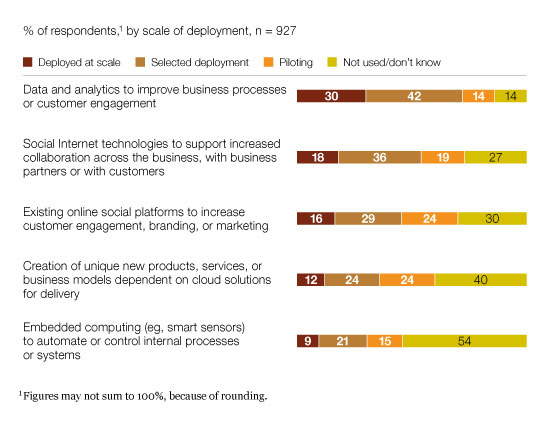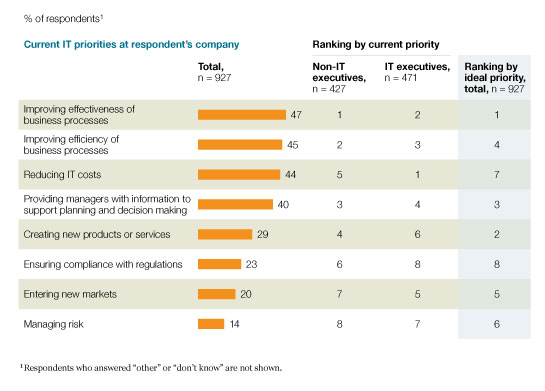“The aspirations – and current expectations – for IT have never been higher.” That’s how McKinsey starts an article on its sixth annual business technology survey, released in December 2011.
Creating platforms to support innovation and growth, dealing with strategic demands for better data and analytics, and, obviously, mobile, are among many other IT priorities.
However, regardless of the exact IT priorities and key technology areas, the main takeaway is that the role of IT is growing, as is also reflected in the willingness to spend more on information technology, in the types of investments and in their goals. It’s clear that this demand from ‘the business side’ will continue to grow as digitalization and transformation priorities continue to grow with an accelerating adoption of what IDC called third platform technologies earlier in 2011 and emerging technologies which are growing on top of them, such as the Internet of Things, and leading to change in behavior among customers, partners and workers.
Customer-centricity and user friendliness become IT priorities
King customer in the broadest sense in many sense is becoming the center of it all, both internal (your workers and ‘users’) and external customers (buyers, partners,….).
This is especially the case if we look at the rationale for the adoption of ‘newer platforms’ as the illustration from McKinsey’s below illustrates.

IT is a means to an end, and if there is anything we should remember from all the surveys, reports and data we have seen in 2011, it is this: businesses are more than ever including IT in their overall business goals, supporting new ways of collaboration and working (work as an activity instead of a place) and, indeed most importantly, focusing on the customer.
We live in times where the customer is at the center of what we do. In fact, he is increasingly in control. Now, haven’t we heard this all before? Yes, we have. Customer-centricity has been a slogan since we started talking about CRM. Today, organizations that still see it as a slogan, instead of a business reality, are missing the point. After all, if you look at the classic business goals such as optimizing profit, reducing costs and enhancing customer satisfaction, in this day and age it increasingly revolves around the needs and preferences of changing customers, workers, in other words: people.
The gradual shift in IT priorities: getting the essence better to better engage stakeholders
True, IT priorities, are mainly revolving around business process optimization (effectiveness and efficiency), reducing IT costs and providing managers with information to support planning and decision making.
However, if you look at the earlier mentioned newer platforms and the simple fact that at the end of a business process is a customer or partner, optimization is a mix of cost savings and, inevitably, being more in tune with the need for speed and ease of use which is simply demanded by today’s worker and customer.
While mainly internally oriented business goals might be driving the agenda of IT priorities, expect a growing role for the customer dimension in its purest form. And, again, optimization, automation and data are not the enemy of customer-centricity, at least if properly considered, planned and executed across silos.

IT priorities: connecting the disconnected
Finally, let’s not forget that, despite the rosy outlook for IT investments as depicted in McKinsey’s survey, the economic outlook is not rosy at all.
Making a difference in tough circumstances will be, as it really always has been, about putting the business goals and thus by definition customers first. Efficiency, speed of business, agility and properly measured processes that go beyond organizational silos, go hand in hand with customer satisfaction, operational excellence and profit.
Decisions need to be supported with the right data, both on the business and customer side. There is no room for disconnected business processes anymore. Everything is connected despite the increasing number of technologies and devices, and the complexity of a multichannel customer.
IT is more important than it was before and expectations are indeed high. Effectiveness, customer-centric innovation and properly aligned priorities are the keywords to remember when it boils down to the specific expectations we should keep in mind.
Organizations are connected ecosystems that have to interact with their customers in a consistent way by overcoming internal challenges and collaborating as a whole.
The customer demands it. Your employee, partner and everyone else in your ecosystem is a customer as well. And, trust me, the customer is more demanding than ever. Are you ready to listen?
All findings from McKinsey’s report can be read here.

